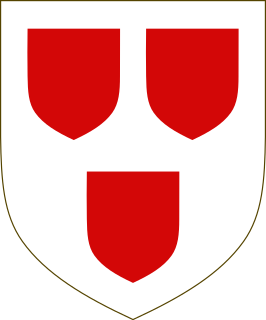
The Wars of Scottish Independence were a series of military campaigns fought between the Kingdom of Scotland and the Kingdom of England in the late 13th and early 14th centuries.
Humphrey (VII) de Bohun, 4th Earl of Hereford was a member of a powerful Anglo-Norman family of the Welsh Marches and was one of the Ordainers who opposed Edward II's excesses.

Sir Gilbert de la Hay, fifth feudal baron of Errol in Gowrie, was Lord High Constable of Scotland from 1309.
The Harrying of Buchan, also known as the Herschip (hardship) or Rape of Buchan, took place in 1308 during the Wars of Scottish Independence. It saw vast areas of Buchan in northeast Scotland, then ruled by Clan Comyn, burned to the ground by Robert the Bruce and his brother Edward, immediately following their success at the Battle of Barra.

Sir David de Brechin was a Scottish knight who fought on both sides during the Wars of Scottish Independence.

Sir William Bisset was a knight, sheriff and constable in the 13th and 14th centuries.
The Sheriff of Ross, Cromarty and Sutherland was historically the office responsible for enforcing law and order in Ross-shire, Cromarty and Sutherland, Scotland and bringing criminals to justice.
Alexander Pilche was a 13th-century Scottish burgess. He joined with Andrew de Moray during the 1297 uprising in northern Scotland against the administration and overlordship of King Edward I of England. He was the Governor of Inverness Castle on behalf of the English in 1304. before being replaced in 1305 and joining King Robert I of Scotland's campaign in Moray in 1307. As a reward he was appointed Sheriff of Inverness until his death.
Cromarty Castle was a castle in Cromarty, Scotland. Cromarty, then known as Crumbathyn, was created a royal burgh in the reign of King Alexander I of Scotland. Cromarty overlooks the entrance to the Cromarty Firth and was strategically important. A motte-and-bailey castle was built in the 12th–13th century. The castle was held by Sir William de Monte Alto during the Scottish wars of independence for both the English and the Scottish.
Sir Hugh de la Haye of Locharwart, was a 13th-14th century Scottish knight.

Sir Alexander Lindsay, Lord of Barnweill, Byres and Crawford, also known as Alexander de Lindsay, was a Scottish noble.
David de Berkley of Cairns/Carny was a 13th-14th century Scottish noble.
Sir Walter de Berkley 8th of Gartly was a 13th-14th century Scottish noble.
Sir Patrick de Graham of Kincardine was a 13th-century Scottish noble and soldier.
Sir Nicholas de la Haye, Baron of Errol was a 13th-14th century Scottish noble.

Richard Siward, Lord of Kellie, was a 13th-14th century Scottish noble. He was the son of the English adventurer Richard Siward and his wife, the wealthy heiress and widow Philippa Basset countess of Warwick, who had married in 1230. His parents divorced in 1242 and young Richard remained in the custody of his father by the terms of the settlement. The Siwards moved north to Scotland after this, where King Alexander II offered the elder Richard a place in his household and gifts of land in Fife, including Kellie and lands in Aberdour. On his death in 1248 the young Richard remained in Scotland, presumably as a royal ward. He inherited no share of his mother's lands.
William Wiseman, Sheriff of Elgin (1304-1305) was a 13th-14th century Scottish nobleman. He was a soldier during the First War of Scottish Independence.
Sir Bernard de Monte Alto was a Scottish knight who took part in the War of Scottish Independence, as a supporter of Robert de Brus.

Sir William de Fenton, Lord of Baikie and Beaufort, was a 13th-14th century Scottish noble.
Dalswinton Castle, also known as Comyn's Castle, was a castle that was located to the south-east of Dalswinton, in Dumfries and Galloway, Scotland.







